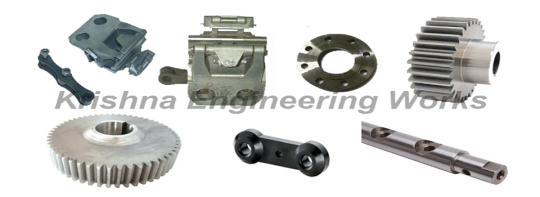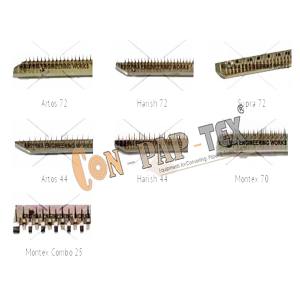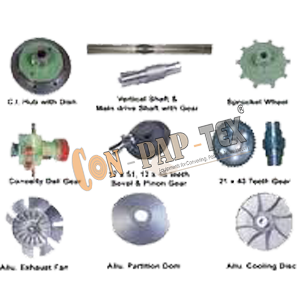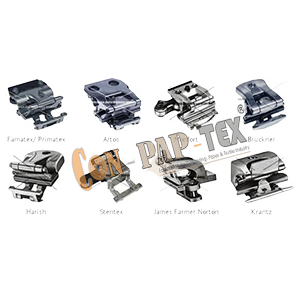#Over Feed For Stenter Machine
Explore tagged Tumblr posts
Link
Textile Machinery Spare Parts Manufacturer like Stenter and Jigger Machine spare parts, Cloth Guider, Textile Rotary Printing Machine Spares form India. Over Feed for Stenter Machine. In the Textile Machinery, we manufacture, export & supply Stenter Machine, Chain Link Bottom Parts, Jigger Machine, Cloth Guider, Folding Machine, Rotary Printing Machine Parts, Bowl Mangle & Drying Range, Gear Set, Spinning & Weaving Machine, Rubber Rollers, and Rubber Fillet from India. We have been successfully manufacturing, exporting & supplying all types of above Textile machinery. We always have following Spares of Spinning & Weaving Machine readily available from Stock Heald Frames and Heald Frame Accessories, Reeds, Healds and Drop Pins, Temple Cylinder and Rings, Airjet. Rubber Roller, Wrinkle Removing Rolls, Banana Roller, Bow Roll, Metal Rolls, Metal Bow Expander Roll, Industrial Rollers, Hard Chrome Plated Rolls etc. Spares for Rotary Screen Printing Machine Like Printing Unit Lifting Bevel Box, Hand Wheel, Screen drive Gear Shaft, Screen Drive gear, Fork Assembly, Muff Coupling, Eccentric Type, Bearing, Rollers MS.

#Textile Machinery Spares Manufacturer#Textile Spare parts#Textile Machinery Spare Parts#Spare Parts of Textile Machine#Stenter Machine#Over Feed for Stenter Machine#Textile Rotary Printing Machine#Spinning and Weaving Machine#Wrinkle Removing Rolls#Metal Bow Expander Roll#Industrial Rollers#Banana Roller#Textile Spare Parts Suppliers
0 notes
Link

Over Feed Part Manufacturer, Exporter and Supplier, All type of Stenter Machine Parts, Textile Machinery Spare Parts like, Stenter Clip, Pin Block, Pin Bar. We maintain a comprehensive range of Stenter part of textile machinery. Genuine Overfeed with highly efficient quality, offering high reliability and optimum results and maximum output. All type of equipment manufacturer for flexible packaging, and textile processing machines like Rubber Roller, Air Shaft, Bow Roll and many more.
#Over Feed Part#Over Feed Part Manufacturer#Stenter Machine Over Feed#Textile Machinery Spares#Textile Machinery Spares parts#Stenter Clip#Stenter Machine Clip#Stenter Pin bar#Stenter Machine Pin bar#Stenter Machine Spare#Stenter Machine Spare parts#Stenter Machine Clips#Textile Machinery Parts
0 notes
Link

Stenter Machine Spare Parts Manufacturer India, high-quality Stenter Machine Spare Parts like Chain Link, Stenter Machine Pin Bar, Bottom Parts, Stenter Machine Clip. Stenter Machine Spare Parts like, Stenter Clips, Chain Link Bottom Parts, Pin Block, Loop Chain, Pin Bars, Gear Box Parts, Shaft, Over Feed and Chain Wheels.
1 note
·
View note
Link
Leading manufacturer of Stenter Machine Spare Parts like Chain Link, Bottom Parts, Stenter Machine Pin Bar, Stenter Clip, textile machinery in India. A Textile Machinery Spare Parts Manufacturer, Stenter Machine, Jigger Machine, Rotary Screen Printing Machine, Mechanical Cloth Guiders, Folding Machine, Gear Sets, Nylon Gear Cuppling & Sleeve, Rubber Roller, Stenter Clip, Stenter Machine Pin Bar etc. Stenter Clips of Any Make like Artos, Dhall, Harish, Yamuna, Hi-Tech, S.M., Stenmech Lucy , Bharat Eng., Monfort, Montex, Swastik, Bruckner, Babros, Ambika, Famatex, etc. Chain Link & Bottom Parts (Pin Block, Loop Chain) of Any Make Stenter Machine. Pin Bars - Any make like Artos, Harish, Supra, Montex etc. Shaft (Main Drive, Driven Horizontal Shaft, etc.) Over Feed (Rubber Pulley Assembly, Drum Pulley Assembly, Post Pin Brush Assembly, Three Finger Uncurrler Assembly).

#Stenter Machine Spare Parts#Textile Machinery#Stenter Machine#Textile Machinery Spare Parts Manufacturer#Jigger Machine#Rotary Screen Printing Machine#Mechanical Cloth Guiders#Folding Machine#Textile Machine Manufacturer#Textile Machine price#Textile Machinery Spare Parts#Textile Machinery Industry#Textile Machinery in India
0 notes
Link

Stenter Machine Pin Bar Manufacturer, Exporter and Supplier for all types of Stenter Machine, high-quality material used in Stenter Pin Bars, Pin Plates, Stenter Clips, Textile Machinery Spare Parts, Chain Link Bottom Parts, Chain Wheels, Stenter Machine, Cloth Guider, Chain Wheels, Feeler Switch, Gear Box Parts, Over Feed, Pin Bars, Stenter Pin plate. Also dealing on Pin Bars for all makes of Stenter Machine more accurate and easy. We are also dealing on pressure dye casted Aluminum alloy pin block and hardened and hard chromed plated pin bar.
#Stenter Machine Pin Bar#Stenter Machine Pin Bar Manufacturer#Stenter Pin Bar#Stenter Clip#Stenter Machine Clip#Chain Link Bottom Parts#Stenter Pin plate#Spares Stenter#Cloth Guider#Textile Machinery Spare Parts
0 notes
Text
Choosing fabric and fabric types
fab-5.jpg Choosing fabric can be overwhelming, there’s often too much choice. When I can’t decide, I ask for small samples that I take away, so I have time to think - even if its just while I have a cup of coffee. Try not to buy on price alone, some of my ‘bargains’ have never been used. Here is a brief overview of the types of fabric used and some tips on working with them. Fab3.jpg Woven Fabric Basic woven fabric is constructed with threads interwoven at right angles to each other. The threads running down the length of the fabric are called the warp and the threads that run across the width are called the weft. This form of construction usually creates a fabric that is rigid or non-stretch in the warp or weft direction although flexible on the bias – an angle of 45 degrees to warp or weft. There are also stretch woven fabrics where Lycra or Elastomeric yarns are included in the weave construction. These fabrics can stretch in one or both directions depending on how the stretch yarn is added in the weaving process. The other form of stretch woven is called a mechanical stretch. This is when a chemical finish is applied to the flat fabric causing it to shrink creating a stretch when pulled. The stretch quality in a mechanical stretch fabric is not as strong or long lasting and will not keep bouncing back. For example if a tight fitting skirt is made in a mechanical stretch fabric it will ‘seat’ and not bounce back until it is washed again. Terms such as denim, canvas or twill, refer to the type of weave pattern. To sew with woven fabrics is fairly straightforward. Use a universal needle and straight stitch setting on your sewing machine. Vary the size of needle and stitch length to suit your fabric weight. fab6.jpg Knitted or Jersey Fabric Knitted fabric is more complex in construction than woven fabric. In its most basic form it is made from a series of interlocking loops formed by a single thread continually looping through the last row of loops created. The resulting fabric is much more flexible than a woven fabric and can stretch in any direction. In a similar way to mechanical stretch woven fabrics, if there is no Lycra or elastomeric content in the yarn used, tight fitting garments will ‘seat’. T-shirts are often made from basic jersey with no added stretch content. The fabric used to make leggings will usually contain 4% - 6%stretch fibres whereas performance sportswear and swimwear require a high percentage approximately 18%. Terms such as single or double jersey refer to the looped construction created by the needle bed set up of the knitting machine. Single jersey is knitted on one bed, either flat or circular, so the loops always fall to the same side, creating a right and wrong side. Double jersey is knitted on a twin bed set up so there is usually two right, though sometimes differing, sides to the fabric. It is generally thicker and more stable to work with. To sew with knitted fabrics use a Ballpoint or jersey needle, these are designed to push the threads aside as they stitch. This prevents any laddering resulting from broken stitches. Selecting the best stitch for jersey fabrics is dependent on the amount of stretch required. Too little stretch and the sewing thread can break when the seam is stretched. For most side seams I like to use a plain straight stitch however I apply a little tension to the fabric as I feed it under the machine foot. For waistbands and hems I use a zigzag stitch to allow for more stretch. If my jersey fabric splays out, I generally use a steam iron, without pressing the fabric, to relax the fabric back into shape. In the Stretch Pencil Skirt project there are a number of alternatives given for tackling hems in different ways. Fab-2.jpg Fine silky fabrics I find these the trickiest to work with but sometimes I can’t resist because of the luxurious delicate handle. Always use a finer needle whether it’s a Universal or Ballpoint. You can also get specialist needles for Microfibre that I have used on natural silks as well as synthetic silky fabrics. For buttonholes try using a stick on fabric stabiliser as used by embroiderers, I use Stitch and Tear. This will stop your fabric puckering up. fab-7.jpg Technical Fabrics This is a term that refers to either woven or knitted fabrics that are coated or bonded with a chemically produced fabrication. PU and PVC are terms used for imitation leathers – PVC stands for plastic Polyvinyl plastic coated woven fabric with a high sheen like patent leather. PU is a Polyurethane coated jersey fabric with a sheen finish and stretch qualities. Neoprene or scuba fabrics are bonded imitation rubber like fabrics with a jersey backing for increased flexibility. For technical fabrics with a jersey backing I’ve found I get the best results from using a ballpoint or jersey needle. For woven backed technical fabrics I use a Universal needle but if that has difficulty puncturing the fabric I use a leather needle. I also lengthen the stitch length to get a smoother result. The shiny surface of these fabrics can stick when in contact with the presser foot or machine plate. To avoid this happening use a Teflon foot and make a template of non-stick baking parchment to place over the machine plate, secure this with tape. For some PVC fabrics It can be impossible to pin your seams in place before stitching so try using a double-sided basting tape or alternatively hold the pieces together with small bulldog or paper clips. Always keep your technical fabrics rolled rather than folded this will stop any permanent creasing. fab4.jpg Leather When sewing with leather select skins that are reasonably lightweight and flexible. If you have never sewn with suede or leather, but would like to have a go, most suppliers have off cuts or part skins at reduced prices, so you can try out before investing in the materials for a whole garment. As leather is neither woven nor knitted fabric it has a tendency to tear at the seams, if there are too many stitch perforations. To avoid this increase your stitch length and always use a leather needle, its spear like point cleanly cuts the stitch hole. Try out the strength of your seam on an off cut. As with technical fabrics, leather can be impossible to pin the seams in place before stitching so try using a double-sided basting tape or alternatively hold the pieces together with small bulldog or paper clips. As with technical fabrics, keep your leather or suede rolled not folded. Before you start making - Once you‘ve bought your fabric always wash it before sewing. If you are not sure it’s washable, cut a 20cm square and place it in a 30-degree wool wash. Then when it’s washed and dried re-measure to check shrinkage and also to review the handle of the fabric. If you don’t like the result, make sure you only dry-clean the garment you are going to make. Before washing lengths of fabric, unfold them and iron out any creases. Loosely load into your machine and use a liquid detergent. These steps should avoid any unevenness in the colour fading especially with indigo and pigment dyed denim or coloured linens. The reason for pre-washing fabric is that during the manufacturing process, fabrics are often ‘stentered’. This is when they are pulled into a uniform width and length and a finishing chemical applied. The problem with this is, that when the fabric is subsequently washed, it ‘relaxes’ back or shrinks. So by washing it before making, you can make sure what you make doesn’t shrink. Do not wash suede, leather or PVC. I have washed PU not because it would shrink but because it can have an unpleasant chemical smell. This article is taken from the book The Makers Atelier - Essential Collection available HERE http://dlvr.it/PQyg9r
3 notes
·
View notes
Text
The Work Principle of The Hot Air Stenter
The Hot Air Stenter is mainly composed of a feeding device, a preheating zone, a high temperature setting zone, a cooling zone and a cloth discharging device. The feeding device is to make the fabric perpendicular to each other under a certain tension or a certain relaxed state including a tension frame, a weft detector, a suction device, an over-feed device, an automatic control device, edge-detector and so on, which can make it smoothly enter the machine. Then, the fabric is heated to a certain temperature through the top hot zone to avoid the cold forming fabric directly entering the high temperature setting zone and affecting the setting temperature. The temperature of the preheating zone should be controlled at around 100 °C. The preheated fabric enters the high temperature setting zone (with steam heating and electric heating device) with the temperature controlled at 150 ° C ~ 230 ° C, so that the fabric is evenly heated for a certain time, after reaching the molding requirements, then enter the cooling zone to cool rapidly, and finally, the fabric is passed through the cloth roller and the cloth dropping frame.
The operation of the fabric in the machine is driven by clip chain or pin-plate or clip chain. A static eliminator should be installed at the fabric outlet, or a steam vent and a metal screen should be installed in front of the fabric roller to spray a proper amount of steam on the cloth surface to appropriately increase the moisture regain of the fabric in order to reduce the generation of static electricity.
In addition to hot air stenter, our printing machine also has a series of attractive features. First of all, the textile printing machine enjoys a large production capacity with a high printing speed under normal circumstances. In addition, the doctor blade is adopted to push the print paste through the design area of the screen onto the fabric. What’s more, our printing machine has a closed screen holder, and the rotary screen printing is driven by direct drive servo motors.
Click hotairstenter for further more information about Licheng Products.
0 notes
Link

#Stenter Chain Wheel#Stenter Machine Chain Wheels#Stenter Spare Parts#Chain Link Bottom Parts#Stenter Machine Pin Bar#Stenter Machine Shaft#Textile Machinery Spare Parts
0 notes
Link
Spares Textile Processing Machinery, Textile Machinery Spare Parts Manufacturer India, Stenter Machine, Jigger Machine, Rotary Screen Printing Machine. Universal (Multi Repeat) Bridge Assembly Drive & Pump Side for 640,820,914. Single Repeat Bridge Assembly Drive & Pump Side for 640,820,914. Universal Screen Setting Assembly (RH / LH). Screen Setting Assembly (RH / LH). Screen Guide Bearing Bracket. Screen Guide Bearing & Pin. Stenter Machine Spare Parts like, Stenter Clips, Chain Link Bottom Parts, Pin Block, Loop Chain, Pin Bars, Gear Box Parts, Shaft, Over Feed and Chain Wheels. Cloth Guider Spare Parts, Bracket left & right, Base Plate Alluminium Left, Base Plate Alluminium Right, Tope Fiber Roller Laminated complete, and Fiber Roller Laminated only. Healed Frames and Healed Frame Accessories. Reeds, Heralds and Drop Pins. Spinning Weaving Machinery Spare Parts.
https://youtu.be/NqBr-6efPf8
#Stenter Machine#Textile Machinery Spare Parts#Textile Machinery#Textile Machine price#Textile Machine spare parts#Textile Machine Manufacturer#Jigger Machine#Rotary Screen Printing Machine#Textile Machinery Spare Parts Manufacturer India#Spares Textile Processing Machinery#Spinning Weaving Machinery Spare Parts#Stenter Machine Spare Parts#Cloth Guider Spare Parts#Folding Machine Spare Parts
0 notes
Link
Krishna Engineering Works is Best Stenter Machine Manufacturer in India also Manufacturing Spare Parts like Overfeed for Stenter Machine at best price and Standard Quality, We have a highly qualified engineering team who proper analysis and surveying every products quality. For more information contact us.

#Stenter Machine Spare Parts Manufacturer#Machine Parts Manufacturer#Machine Manufacturer#Stenter Machine#Stneter Machine Parts Supplier#Stenter Machine Parts Exporter#Parts Manufacturer
0 notes
Link

We are leading manufacturer, exporter and supplier of Chain Wheels Manufacturer, all type of Stenter Chain Wheels and Stenter Machine Spare Parts manufacturer with high quality material, Textile Machinery. Chain Link Bottom Parts, Chain Wheels, Feeler Switch, Gear Box Parts, Over Feed, Stenter Machine Pin Bar, Shaft, Stenter Clips, Textile Machinery Spare Parts, Cloth Guider, Stenter Clip Manufacturer, Stenter Pin bar Manufacturer, Stenter Machine Manufacturer. Web Guiding System for textile processing machinery.
#Stenter Chain Wheel#Stenter Machine Chain Wheels#Stenter Spare Parts#Chain Link Bottom Parts#Stenter Machine Pin Bar#Stenter Machine Shaft#Textile Machinery Spare Parts#Cloth Guider#Stenter Clip Manufacturer#Stenter Pin bar Manufacturer#Stenter Machine Manufacturer
0 notes
Link

We are leading Manufacturer, Exporter and Supplier of Stenter Clips with high quality material, Stenter Machine Pin Bar, Stenter Pin Block, Cloth Guider, Stenter Spare Parts, Chain Link Bottom Parts, Chain Wheels, Feeler Switch, Gear Box Parts, Over Feed, Pin Bars, Shaft, Stenter Clips, Textile Machinery Spare Parts, Cloth Guider manufacturer. This clip can exhibit an excellent performance as a high speed clip. Our Stenter Chips are designed for the finishing of cloth which have hard tension.
#Stenter Clips#Stenter Clip#Stenter Machine Clips#Stenter Machine Clip#Stenter Machine Pin Bar#Stenter Pin Bar#Chain Link Bottom Parts#Textile Machinery Spare Parts#Cloth Guider manufacturer#Cloth Guider manufacture#Cloth Guider#Stenter Pin Bars
0 notes